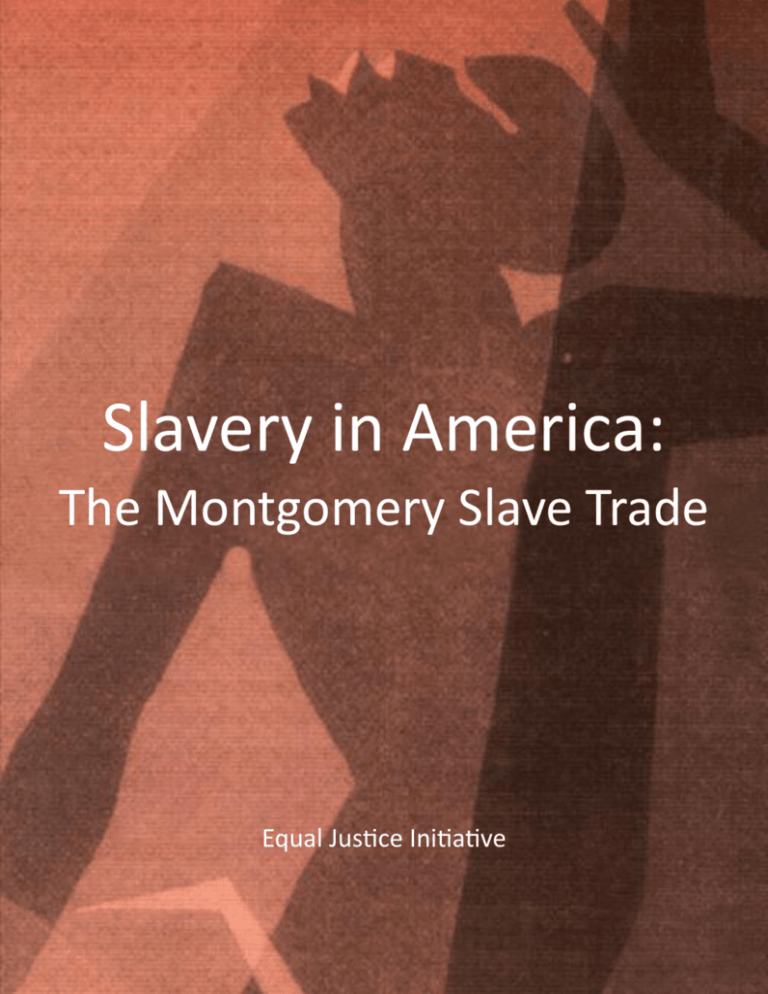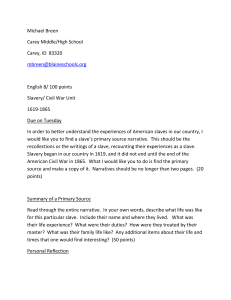
Slavery in America:
The Montgomery Slave Trade
Equal Justice Initiative
SlavEry In amErIca
Beginning in the seventeenth century, millions of
African people were kidnapped, enslaved, and shipped
across the Atlantic Ocean to the Americas under horrific
conditions that frequently resulted in starvation and
death. Nearly two million people died at sea during the
agonizing journey.
As American slavery evolved, an elaborate and
enduring mythology about the inferiority of black people
was created to legitimate, perpetuate, and defend
slavery. This mythology survived slavery’s formal
abolition following the Civil War.
In the South, where the enslavement of black people
was widely embraced, resistance to ending slavery
persisted for another century following the passage of
the Thirteenth Amendment in 1865. Today, 150 years
after the Emancipation Proclamation, very little has been
done to address the legacy of slavery and its meaning in
contemporary life.
(Opposite: Photo donated by Corbis.)
1
“Taken on board ship, the naked Africans were shackled
together on bare wooden boards in the hold, and packed so
tightly that they could not sit upright. During the dreaded MidPassage (a trip of from three weeks to more than three months)
. . . [t]he foul and poisonous air of the hold, extreme heat, men
lying for hours in their own defecation, with blood and mucus
covering the floor, caused a great deal of sickness. Mortality
from undernourishment and disease was about 16 percent. The
first few weeks of the trip was the most traumatic experience for
the Africans. A number of them went insane and many became
so despondent that they gave up the will to live. . . . Often they
committed suicide, by drowning or refusing food or medicine,
rather than accept their enslavement.”
JOhN W. BlASSINgAME, ThE SlAvE COMMuNITy 7 (1979).
Imprisoned men at Maula Prison in Malawi are forced to sleep “like the enslaved on a slave
ship.” (Joao Silva/The New York Times/Redux.)
2
Though the reality of American slavery was often brutal,
barbaric, and violent, the myth of black people’s racial inferiority
developed and persisted as a common justification for the
system’s continuation.
Slavery deprived the enslaved person of any legal rights or
autonomy and granted the slaveowner complete power over the
black men, women, and children legally recognized as his
property.
Enslaved African children taken aboard HMS Daphne, November 1868. (The National
Archives of the UK: ref. FO 84/1310 (b).)
3
4
The racialized caste system of American slavery was
unique in many respects from the forms of slavery that
existed in other parts of the world. In the Spanish and
Portugese colonies, for example, slavery was a class
category or form of indentured servitude – an “accident”
of individual status that could befall anyone and could
be overcome after a completed term of labor or
assimilation into the dominant culture.
American slavery began as such a system. When the
first Africans were brought to the British colonies in 1619
on a ship that docked in Jamestown, virginia, they held
the legal status of “servant.” But as the region’s
economic system became increasingly dependent on
forced labor, and as racial prejudice became more
ingrained in the social culture, the institution of
American slavery developed as a permanent, hereditary
status centrally tied to race.
Opposite: Many enslaved and orphaned children were abandoned during the turmoil of
the Civil War. (George Eastman House, International Museum of Photography and Film.)
5
6
Opposite: An enslaved man, Private Gordon, was beaten so frequently that the multiple
whippings left graphic scars depicted in this 1863 photograph. (Donated by Corbis.)
Enslaved people suffered extreme physical violence as
punishment for running away, failing to complete assigned tasks,
visiting a spouse living on another plantation, learning to read,
arguing with whites, working too slowly, possessing anti-slavery
materials, or trying to prevent the sale of their relatives.
Enslaved people who have just escaped from a Virginia plantation in 1862. (Library of
Congress.)
7
The Domestic Slave Trade
In 1808, the united States Congress banned the importation
of slaves from Africa. At the same time, the high price of cotton
and the development of the cotton gin caused the demand for
slave labor to skyrocket in the lower South. The Domestic Slave
Trade grew to meet this demand. Over the next fifty years, slave
traders forcibly transferred hundreds of thousands of enslaved
people from the upper South to Alabama and the lower South.
Between 1808 and 1860, the enslaved population of Alabama
grew from less than 40,000 to more than 435,000. Alabama had
one of the largest slave populations in America at the start of the
Civil War.
Slave Transportation to montgomery
In order to meet the high demand for slaves in Alabama in
the early 1800s, slave traders chained African Americans
together in coffles and forced them to march hundreds of miles
from the upper South to the lower South, including
Montgomery. The overland transportation of enslaved people
by foot was slow and expensive. By the 1840s, slave traders
began to take advantage of two new modes of transportation:
the steamboat and the railroad. Steamboats carried slaves from
Mobile and New Orleans up the Alabama River to Montgomery.
Rail routes constructed with slave labor connected
Montgomery’s train station to West Point, georgia, and lines
extending to the upper South. hundreds of enslaved people
began arriving by rail and by boat each day in Montgomery,
turning the city into a principal slave trading center in Alabama.
Enslaved people who arrived at the riverfront or at the train
station were paraded up Commerce Street to be sold in the city’s
slave markets.
8
Downtown montgomery, alabama
Alabama River
Slave
Import
Site
n
tio
a
St
n
i
Tra
Slave
Import
Site
ve
Sla
Warehouse and
Slave Pen
EJI
s
an
Tr
Slave Depot
r
po
ou
tR
te
Slave
market
Slave
Depot
Slave
Depot
Slave
Depot
Slave
Pen
Overland Slave Importation Route
The montgomery Slave Trade
Montgomery had grown into one of the most prominent slave
trading communities in Alabama by 1860. At the start of the Civil
War, the city had a larger slave population than Mobile, New
Orleans, or Natchez, Mississippi. Montgomery attracted a
growing number of major slave traders whose presence
dominated the city’s geography and economy. The Montgomery
probate office granted at least 164 licenses to slave traders
operating in the city from 1848 to 1860. Slave trader’s offices
were located primarily along Commerce Street and Market Street
(now Dexter Avenue). Over time, Montgomery became one of
the most important and conspicuous slave trading communities
in the united States. After the Alabama legislature banned free
black people from residing in the state in 1833, enslavement was
the only legally authorized status for African Americans in
Montgomery.
(Courtesy of The New York Public Library, www.nypl.org.) (Opposite: Equal Justice Initiative photo.)
10
11
Warehouses Used in the Slave Trade
Commerce Street was central to the operation of
Montgomery’s slave trade. Enslaved people were marched in
chains up the street from the riverfront and railroad station to
the slave auction site or to local slave depots. Warehouses were
critical to the city’s slave trade. Slave traders confined enslaved
people in warehouses until they could be sold during slave
auctions. At 122 Commerce Street was a very large warehouse
owned by John Murphy, who provided support to slave traders
in the city and built the Murphy house on Bibb Street. The
Commerce Street warehouse was used in the 1850s by slave
traders like h.W. Farley, who advertised the sale of enslaved
children, such as a boy “about fourteen, very likely and sprightly.”
The warehouse remained in the hands of owners involved in the
slave trade until the end of the Civil War.
montgomery’s Slave Depots
Montgomery slave traders operated depots where enslaved
men, women, and children were confined. The slave depots
functioned as active trading sites and as detention facilities
where the enslaved were held captive until they were auctioned
at Court Square. The city had four major slave depots. Three of
the depots lined Market Street (now Dexter Avenue) between
lawrence and McDonough and were owned by Mason harwell,
S.N. Brown, and E. Barnard & Co. In 1859, Montgomery had as
many slave depots as it did hotels and banks. The slave trade
continued to thrive in Montgomery even during the Civil War. As
late as 1864, Thomas l. Frazer opened a new slave depot on
Market Street and sold boys and girls “of all descriptions.”
12
During the last twenty years of American slavery,
no slave market was more central or conspicuous
than the one in Montgomery, Alabama.
Court Square in downtown Montgomery, Alabama, looking down Commerce Street.
(Ala. Dep’t. Archives and History, Montgomery, Ala.)
13
montgomery’s Slave Traders
vast plantations with large slave populations emerged in Alabama’s Black Belt beginning in 1820. Montgomery’s proximity
to the Black Belt made the city a center for slave trading in Alabama. From the river, down Commerce Street to Market Street,
slave traders worked next door to shop owners and other business establishments. E. Barnard & Co. operated at 88 Commerce
Street. Mason harwell, one of Montgomery’s most active slave
traders, kept an office at 21 Market Street (now Dexter Avenue).
On a single day, harwell sold hundreds of enslaved men, women,
and children alongside livestock. Across the South, slave traders
were generally among the wealthiest and most influential citizens in their communities.
Illustration of Montgomery’s slave market published in 1861. (Donated by Corbis.) Opposite: Several
slave depots could be found in downtown Montgomery advertising people for sale. (Ala. Dep’t.
Archives and History, Montgomery, Ala.)
14
15
16 Montgomery, Alabama, 2011. (Photo by Stephen Chu.)
Slavery in America traumatized and devastated millions of
people. It created narratives about racial difference that still
persist today. It also fostered bigotry and racial discrimination
from which we have yet to fully recover. In learning more about
slavery, we can learn more about ourselves, our past, and
hopefully, our future. By strengthening our understanding of
racial history, we can create a different, healthier discourse about
race in America that can lead to new and more effective
solutions.
EJI’s race and Poverty Project
The Equal Justice Initiative is a private, non-profit organization
that provides legal assistance to the poor, the incarcerated, the
condemned, children prosecuted as adults in the criminal justice
system, and communities marginalized by bias, discrimination,
or poverty.
Our project on race and poverty examines today’s issues
through the lens of America’s racial history. The legacy of slavery,
racial terror, and legally supported abuse of racial minorities in
the united States is not well understood. We believe that civil
and human rights are often compromised by our failure to
confront our history with greater clarity and thoughtfulness.
This report is designed as one of several tools for learning
more about racial history. Additional materials on the legacy of
racial injustice, and information about the work of EJI, can be
found at www.eji.org.
17
Equal Justice Initiative
122 Commerce Street
Montgomery, Alabama 36104
334.269.1803
www.eji.org
© 2013 by Equal Justice Initiative. All rights reserved. No part of this publication may be reproduced, modified, or
distributed in any form or by any electronic or mechanical means without express prior written permission of Equal
Justice Initiative (EJI). EJI is a nonprofit law organization located in Montgomery, Alabama.









